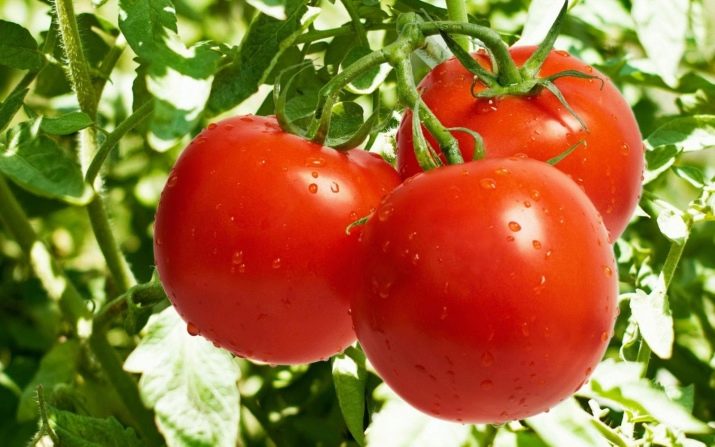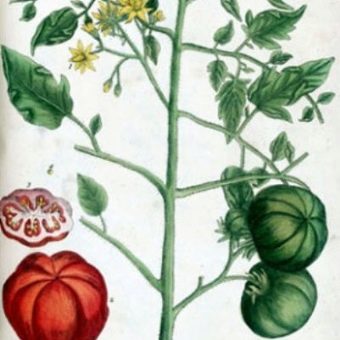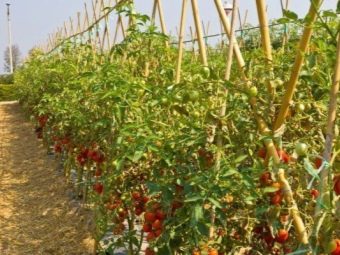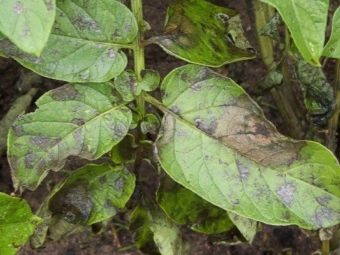Is a tomato a berry or a vegetable?

The fruits of tomatoes, so beloved by gardeners, without exception, for many years have caused heated debate about their affiliation to plant species.The reason for this is the difference in the definitions and classification of edible crops among botanists and culinary specialists.
Botanical scientific literature classifies tomatoes exclusively to the berries. The argument in favor of this definition are the following signs:
- the growth of the fruit on the bushes;
- the form;
- thin skin with juicy pulp;
- abundance of small seeds, which after maturation fall to the ground and give new shoots.
The seeds in the fruit and the way of the reproduction of tomatoes in the wild nature serve as the main argument, because by this principle all berries reproduce without exception. For the same reason, watermelon is also considered a berry.
However, the culinary community is in dispute with the scientific community. Adopted several centuries ago, the unwritten rules for the classification of vegetables, fruits and berries did not appear from scratch. The answer to this question lies in history.
History reference
Homeland of tomatoes is considered to be South America. Opinions of researchers differ on this issue, but it is known for certain that tomatoes got to Europe thanks to European navigators-conquerors. They brought to the continent an unprecedented plant with red berries, which the Indians called "tomato".
For a long time, Europeans were suspicious of strange red fruits, but they were considered extremely beautiful. Bushes of tomato began to grow in greenhouse tubs, on balconies, in open flower beds. Fortunately, the climate of Portugal, Spain, Italy allowed tomatoes to grow in all their glory, without requiring special care.
Up until the beginning of the 19th century, tomatoes were considered a poisonous plant and were not eaten.
In the Russian Empire, the first written evidence about tomatoes appeared in the time of Catherine II. Sources claim that European ambassadors, among other gifts and delicacies, brought the unusual fruits of bright red color to the Empress. According to other information, tomato cultures were grown before in the southern regions of the empire - in the Crimea and in the Caucasus.
What family does it belong to?
From a botanical point of view, a tomato occupies a certain place in the classification of plants. In order to understand the issue of belonging of tomatoes to berries or vegetables, it will be useful to get acquainted with the scientific definitions of tomato.
So, opening any encyclopedia of plants, you can find out that a tomato is a herbaceous plant of the type of nightshade. It includes more than one hundred small genera of plants and a little less than three thousand species. Solanaceae are represented by grasses, shrubs, small trees. Fruits of Solanaceae have the form of either berries or boxes. Some fruits (berries) of the nightshade are actively used in food: tomatoes, potatoes, eggplants. In the form of boxes, tobacco, pepper, petunia, henbane are ripening.
Representatives of the nightshade contain in their tissues a toxic substance - solanine. In tomatoes, it predominates in the stem and leaves of the plant. It is because of this substance that tomatoes were once considered inedible.
Characteristic
The plant bush is called a tomato (from the ancient Aztec name "Tomato"). The fruit of a tomato is a berry; in common language it is called “tomato” - in Italian the phrase “pomo doro” means “golden apple”.
The plant has a well-developed root system with a central rod-shaped root and a large number of small processes. The diameter of the spread of the roots can reach 2.5 meters at a depth of 1 m. The stem is erect, in some liana-like varieties can reach a height of 3-4 meters. The arrangement of leaves is alternate, flowers of regular shape, fruits are tied with tassels.
Tomatoes are fleshy berries with small seeds. May have different color and size depending on the variety. The shape is round, drop-shaped or cylindrical. Weight ranges from 50 g to 1 kg. Pigmentation of classic fruits includes the whole range of red shades, yellow, white colors.
Among their analogues, tomatoes are classified according to the following criteria:
- bush growth type: determinant (short) and indeterminant (tall);
- ripening time: early, mid-ripening, late.
Growth features
Tomato is a heat-loving and light-loving culture that grows on open ground only in southern regions, where the hot summer turns into a warm autumn and velvet season. In cooler areas, tomatoes are successfully grown in closed greenhouses and greenhouses.
Favorable temperature for ripening fruits - 23-25 degrees. With a decrease in temperature, the bush slows growth, and at a mark on the thermometer below +10, it throws off the brush and may die.
Tomatoes require not frequent, but abundant watering at the root. Increased humidity and water droplets on the leaves leads to fungal diseases of the plant. The most common of these is late blight - a constant companion of tomatoes in cool regions with insufficient sunshine.
The plant is sensitive to any additives in the soil, so fertilizer should be added carefully.
The main trace elements necessary for a tomato are nitrogen, potassium and phosphorus.
Benefit and harm
Tomato fruit can certainly be called a pantry of vitamins. Each tomato contains the whole complex of mineral substances with a sufficiently low caloric content. Tomatoes include fiber, vegetable protein, amino acids and enzymes that can break down and remove toxins from the body. Tomatoes are rich in vitamins A, B, C, trace elements of potassium, magnesium, sodium, calcium and iron.
The complex of nutrients of tomatoes includes:
- Lycopene - An antioxidant substance that slows the aging process in the body. In cosmetology, masks from the tomato mass are used to combat facial wrinkles, acne and skin inflammations. Lycopene also contributes to women's health, helps to overcome age-related changes.
- Alpha-tomatin - contributes to the prevention of cancer, slows the growth of cancer cells. Cancer today is a little-known disease that takes the lives of millions of people. Therefore, it will be useful for everyone to think about prevention, especially since tomatoes are a welcome treat on any table.
- Tyramine - has a beneficial effect on the thyroid gland, has the properties of serotonin - "the hormone of happiness." For those who want to lose weight, this is a great alternative to the chocolate bar. Tyramine improves performance, activates thought processes that can be used during school or work that requires serious concentration.
It is recommended to eat tomatoes not only as a preventive product, but also for certain diagnoses of serious diseases.
Substances contained in tomatoes, improve intestinal motility, have a laxative effect, contribute to the removal of toxins from the liver. Indications for use: ulcers, low intestinal permeability, gastritis with low acidity.
Trace elements of tomato contribute to the acceleration of metabolism, normalize metabolic processes and restore hormonal levels. Doctors recommend including tomatoes in the diet for the prevention of diabetes, diseases of the thyroid gland.
Regular consumption of the product contributes to the normalization of pressure, increases the elasticity of blood vessels, dilutes the blood, thereby significantly reducing the risk of blood clots. It is recommended to introduce it into the daily diet for all people suffering from atherosclerosis, angina, varicose veins.
As with any natural product with a significant supply of nutrients, tomatoes have contraindications. The human body is individual and in some cases, excessive consumption of tomatoes can cause significant harm.
First of all, it should be remembered that an excess of certain substances in the body can cause an allergic reaction. This is especially true of allergy sufferers from the action of certain trace elements.
Do not get involved in canned tomatoes.Marinade contains an increased amount of vinegar and salt, which, in conjunction with the acids of tomatoes, can cause an exacerbation of gastric diseases.
People with urinary diseases are advised to use caution when eating tomatoes. Oxalic acid in tomato can cause renal exacerbations.
As noted above, tomatoes have a positive effect on the work of the gastrointestinal tract, but only in cases of normal functioning or with a low level of acidity.
Therefore, in case of peptic ulcers, pancreatitis, the acids contained in tomatoes can cause significant harm to health.
Interesting information
Despite all the scientific rationale, tomatoes are considered to belong to vegetable crops and nothing else. And the reason for this amazing story that occurred in the XIX century in America. Tomatoes, which had already settled on the European continent, returned to their historic homeland as a claimed edible culture. Mass trade in these fruits has acquired an unprecedented scale, and even became the reason for the trial.
The case was just a dispute about the classification of tomatoes. And the reason for it was very mercantile - vegetables at that time were subject to higher customs duties than fruits. Therefore, the court ruled to consider tomatoes a vegetable. The arguments in favor of this decision were the following:
- it is eaten with other vegetables, meat and fish dishes;
- Tomatoes are an independent vegetable, and, unlike berries, are used in vegetable preparations and dishes not only as a sauce;
- The fruits of tomatoes do not have the inherent sweetness of berries, they are extremely rarely used in dessert dishes and preparations with sugar.
Subsequently, these arguments turned out to be sufficient for the definition to be firmly established in society, even if not scientific, that tomato is a vegetable crop.
To learn about the benefits of tomatoes for the body, see the following video.

































